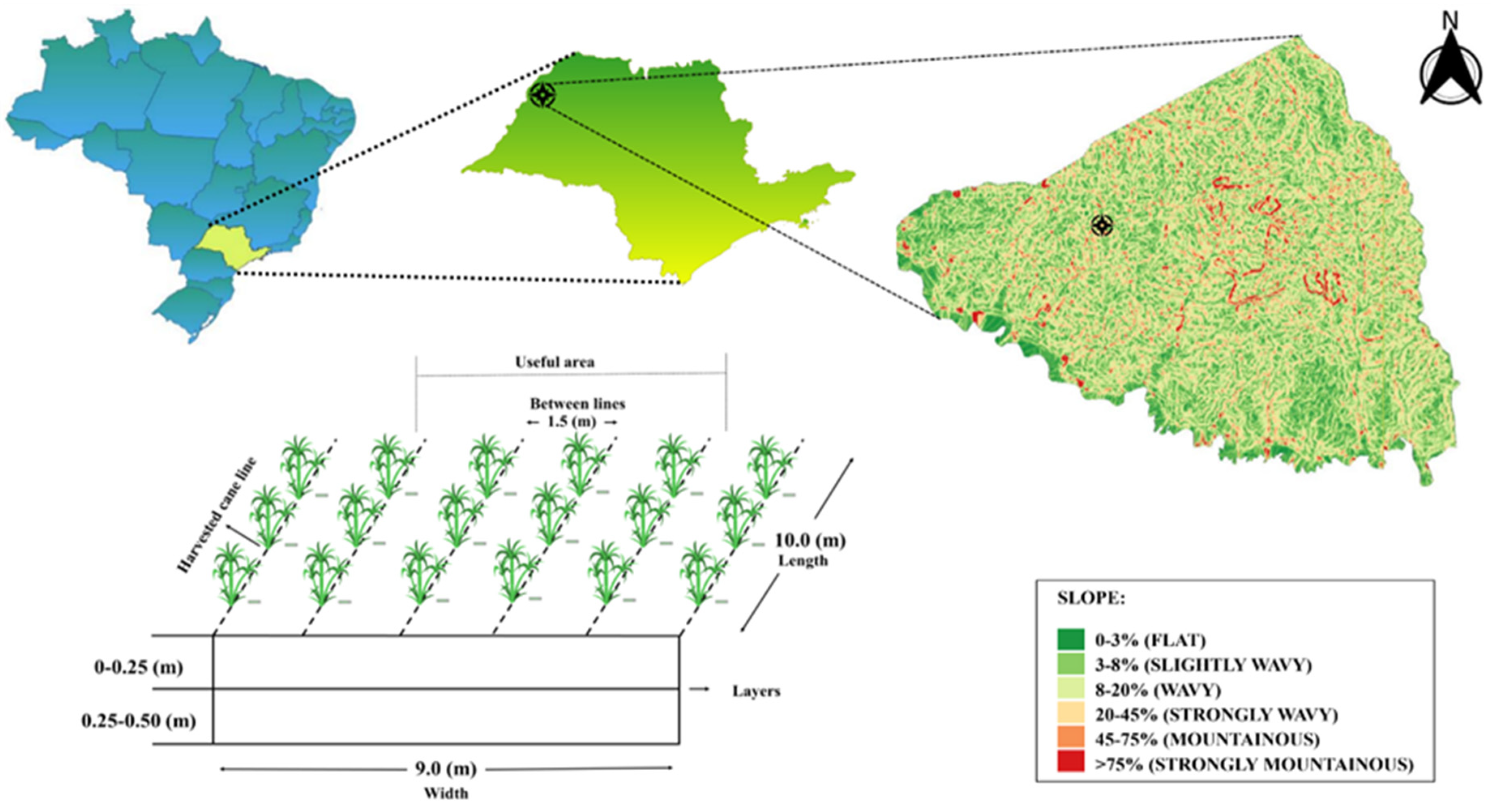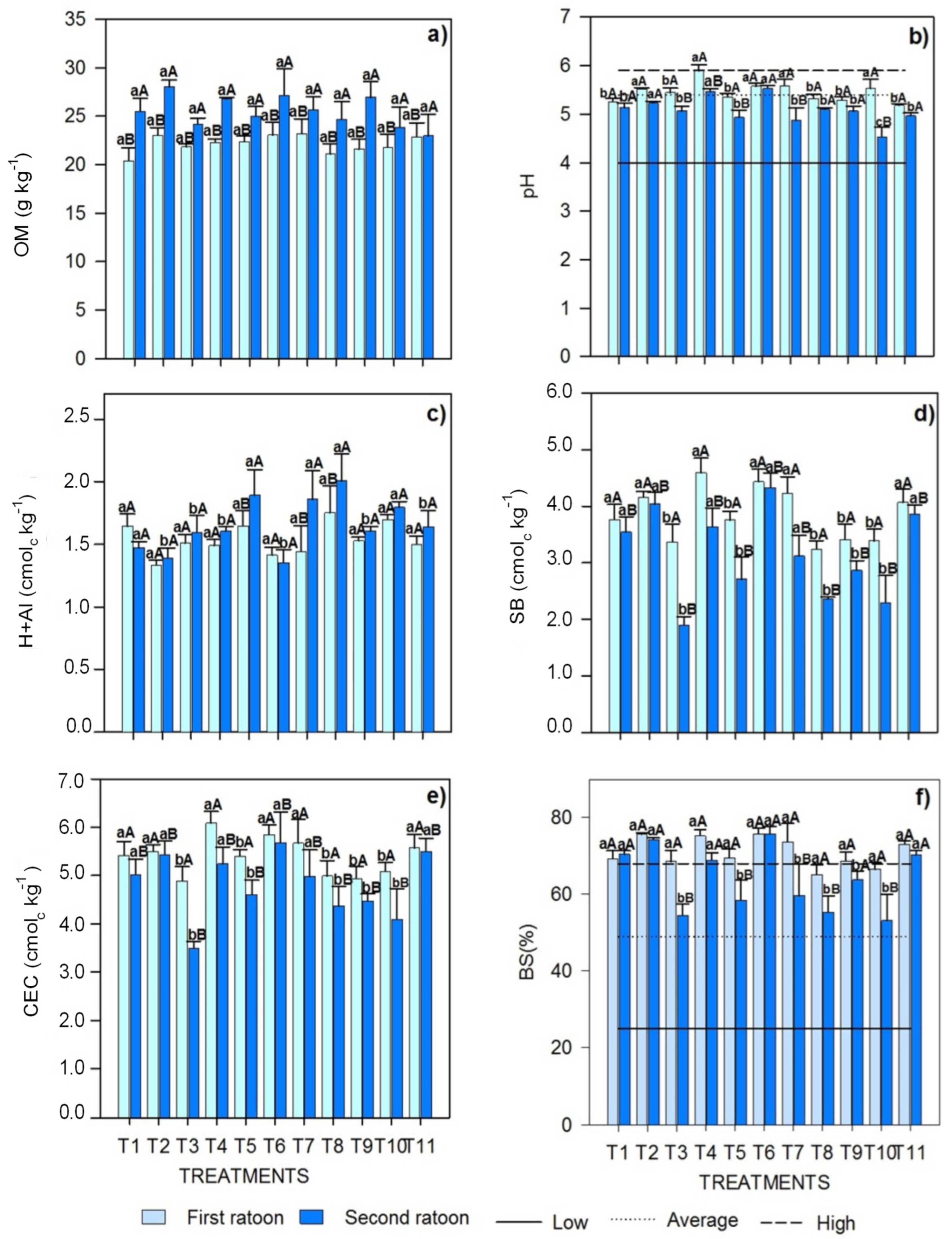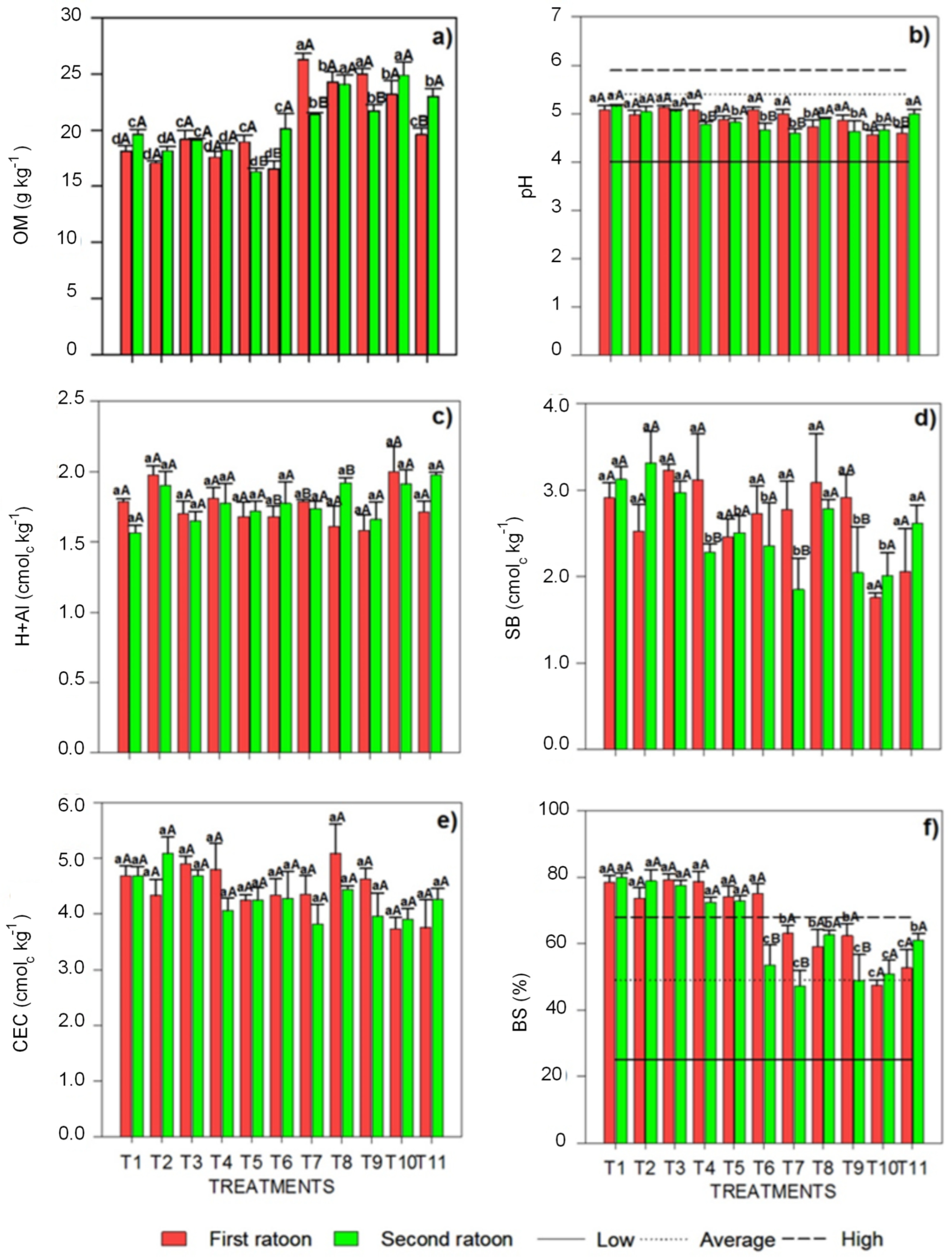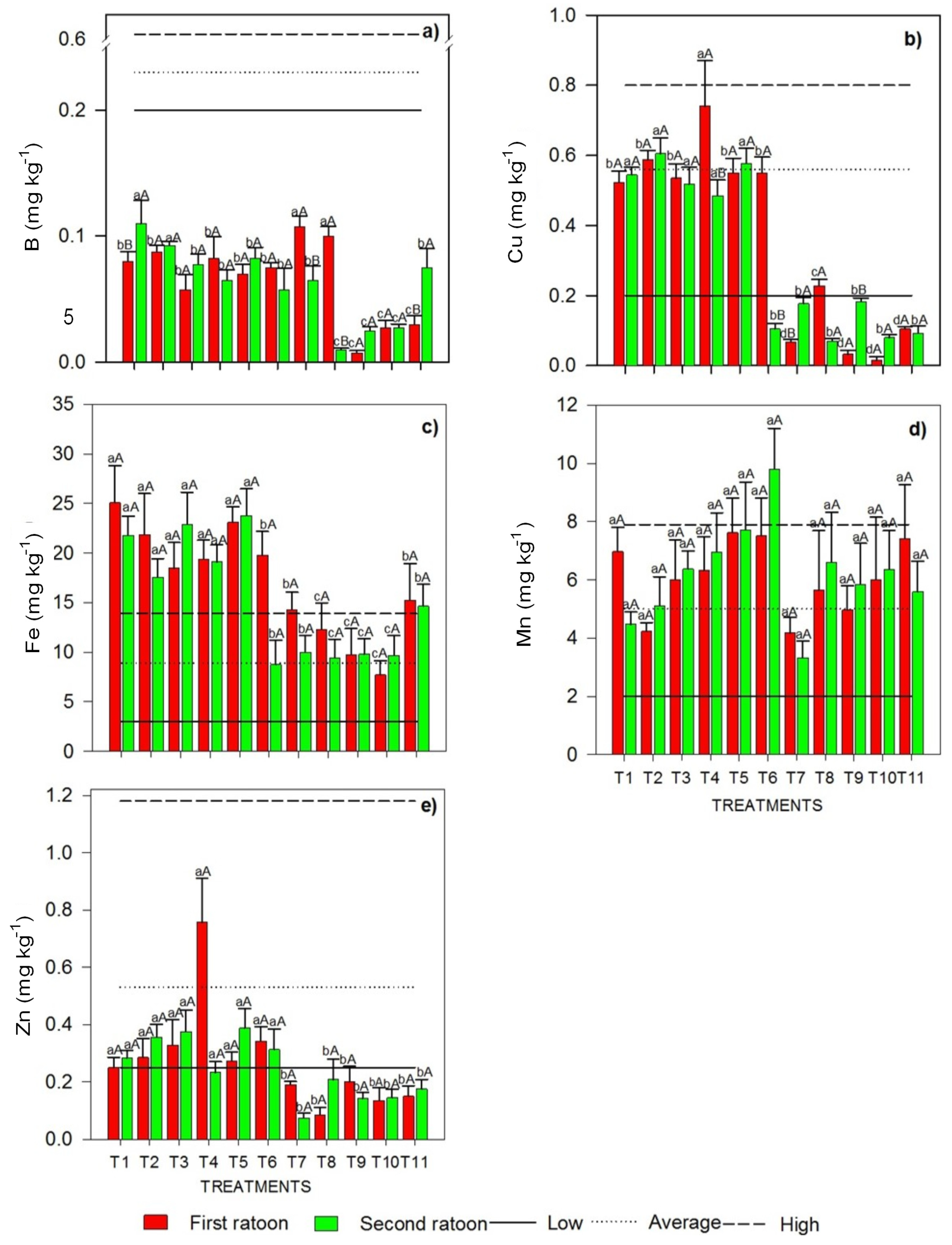Treating Tropical Soils with Composted Sewage Sludge Reduces the Mineral Fertilizer Requirements in Sugarcane Production
Abstract
1. Introduction
2. Materials and Methods
2.1. Description of the Experimental Area
2.2. Treatments and Experimental Design
2.3. Composted Sewage Sludge Characterization
2.4. Field Experiment
2.5. Soil Chemical Analyses
2.6. Statistical Analysis
3. Results and Discussion
4. Conclusions
Supplementary Materials
Author Contributions
Funding
Data Availability Statement
Acknowledgments
Conflicts of Interest
References
- Dias, A.S.; Santos, C.C. Maximizando a produção de canaviais brasileiros: Uma abordagem prática para implantação e manejo nutricional. Manejo fisiológico e nutricional de plantas: Abordagens práticas na agricultura 1. Ed. Cient. Digit. 2023, 1, 29–61. [Google Scholar] [CrossRef]
- Filho, C.H.A.M.; Sousa, R.S.; Neto, F.A.; Silva, V.B.; Diniz, Y.B.; Júnior, G.M.C.; Nascimento, F.N.; Silva, R.R.C.; Sousa, G.L. Avaliação de clones de cana-de-açúcar para produção de biomassa de qualidade na região canavieira do Piauí. Peer Rev. 2023, 5, 188–204. [Google Scholar] [CrossRef]
- CONAB; National Supply Company. Acompanhamento da Safra Brasileira de Cana-de-Açúcar; CONAB: Brasilia, Brazil, 2024. Available online: https://www.conab.gov.br/info-agro/safras/cana/boletim-da-safra-de-cana-de-acucar/item/download/50386_66eb66936a5d73a592e5fb25bc9cb71b (accessed on 12 June 2024).
- Cherubin, M.R.; Carvalho, J.L.N.; Cerri, C.E.P.; Nogueira, L.A.H.; Souza, G.M.; Cantarella, H. Land Use and Management Effects on Sustainable Sugarcane-Derived Bioenergy. Land 2021, 10, 72. [Google Scholar] [CrossRef]
- IBGE—Brazilian Institute of Geography and Statistics. Produto Interno Bruto; PIB: New Delhi, India, 2022. Available online: https://agenciadenoticias.ibge.gov.br/agencia-sala-de-imprensa/2013-agencia-de-noticias/releases/38284-release-contas-nacionais#:~:text=Destaques,e%20a%20Agropecu%C3%A1ria%20ficou%20est%C3%A1vel (accessed on 12 June 2024).
- Zhao, Y.; Cao, J.; Wang, Z.; Liu, L.; Yan, M.; Zhong, N.; Zhao, P. Enhancing sugarcane growth and improving soil quality by using a network-structured fertilizer synergist. Sustainability 2023, 15, 1428. [Google Scholar] [CrossRef]
- Pang, Z.; Huang, J.; Fallah, N.; Lin, W.; Yuan, Z.; Hu, C. Combining N fertilization with biochar affects root-shoot growth, rhizosphere soil properties and bacterial communities under sugarcane monocropping. Ind. Crops Prod. 2022, 182, 114899. [Google Scholar] [CrossRef]
- McCray, J.M.; Rice, M. Nutritional Requirements and Fertilizer Recommendations for Florida Sugarcane; SS-AGR-228/SC028, rev. 1/2023; EDIS: Gainesville, FL, USA, 2023; Available online: https://edis.ifas.ufl.edu/publication/SC028 (accessed on 12 June 2024).
- Cantarella, H.; Quaggio, J.A.; Junior, D.M.; Boareto, R.M.; Raij, B.V. Boletim 100: Recomendações de Adubação e Clagem Para o Estado de São Paulo; Instituto Agronômico de Campinas: Campinas, Brazil, 2022.
- Vasconcellos, G.; Lopes, E.C.; Scheuer, L. Informational Flow of Logistics Processes: Study on the process of fertilizer importation to Brazil. Int. J. Innov. Educ. Res. 2019, 7, 123–132. [Google Scholar] [CrossRef]
- Carpanez, T.G.; Moreira, V.R.; Assis, I.R.; Amaral, M.C.S. Sugarcane vinasse as organo-mineral fertilizers feedstock: Opportunities and environmental risks. Sci. Total Environ. 2022, 832, 154998. [Google Scholar] [CrossRef]
- Souza, A.A.B.; Silva, W.R.; Nascimento, C.W.A.; Silva, Y.J.A.B.; Biondi, C.M. Residual effects of alkalized sewage sludge application on soil quality and sugarcane yield. Arch. Agron. Soil Sci. 2022, 69, 1705–1717. [Google Scholar] [CrossRef]
- CONAMA—National Environmental Council. Resolução N°498. Ministério do Meio Ambiente e Mudança do Clima; CONAMA: Brazilia, Brazil, 2020. Available online: https://conama.mma.gov.br/index.php?option=com_sisconama&task=arquivo.download&id=797 (accessed on 17 June 2024).
- MAPA—Ministry of Agriculture, Livestock and Supply. Normative Instruction SDA No 61 DE 08/07/2020; MAPA: Brazilia, Brazil, 2020. Available online: https://www.legisweb.com.br/legislacao/?id=398558. (accessed on 17 June 2024).
- Prates, A.R.; Coscione, A.R.; Filho, M.C.M.T.; Miranda, B.G.; Arf, O.; Abreu-Junior, C.H.; Oliveira, F.C.; Moreira, A.; Galindo, F.S.; Sartori, M.M.P.; et al. Composted sewage sludge enhances soybean production and agronomic performance in naturally infertile soils (Cerrado Region, Brazil). Agronomy 2020, 10, 1677. [Google Scholar] [CrossRef]
- Dar, Z.A.; Bhat, J.I.A.; Qazi, G.; Ganie, S.A.; Amin, A.; Farooq, S.; Nazir, A.; Rasool, A. Municipal sewage sludge, aquatic weed compost on soil enzymatic activity and heavy metal accumulation in Kale (Brassica oleracea L.). Appl. Water Sci. 2023, 13, 60. [Google Scholar] [CrossRef]
- Feng, J.; Yang, Y.; Ruan, K.; Wu, D.; Xu, Y.; Jacobs, D.F.; Zeng, S. Combined application of sewage sludge, bagasse, and molybdenum tailings ameliorates rare earth mining wasteland soil. J. Soils Sediments 2023, 23, 1775–1788. [Google Scholar] [CrossRef]
- Kazimierowicz, J.; Dębowski, M. Characteristics of solidified carbon dioxide and perspectives for its sustainable application in sewage sludge management. Int. J. Mol. Sci. 2023, 24, 2324. [Google Scholar] [CrossRef]
- Silva, R.S.; Jalal, A.; Nascimento, R.E.N.; Elias, N.C.; Kawakami, K.C.; Abreu-Junior, C.H.; Oliveira, F.C.; Jani, A.D.; Ele, Z.; Zhao, F.; et al. Composted sewage sludge application reduces mineral fertilization requirements and improves soil fertility in sugarcane seedling nurseries. Sustainability 2022, 14, 4684. [Google Scholar] [CrossRef]
- Köppen, W.; Geiger, R. Klimate der Erde; Justus Perthes: Gotha, Germany, 1928. [Google Scholar]
- Soil Survey Staff. Keys to Soil Taxonomy, 12th ed.; Natural Resources Conservation Service: Washington, DC, USA, 2014.
- Raij, B.V.; Andrade, J.C.; Cantarella, H.; Quaggio, J.A. Análise Química Para Avaliação da Fertilidade de Solos Tropicais; Instituto Agronômico: Campinas, Brazil, 2001.
- CONAMA—National Environmental Council. Resolução N° 375. Ministério do Meio Ambiente e Mudança do Clima; CONAMA: Brazilia, Brazil, 2006. Available online: https://conama.mma.gov.br/?option=com_sisconama&task=arquivo.download&id=797 (accessed on 17 June 2024).
- Oliveira, R.A.; Hoffmann, H.P.; Barbosa, G.V.S. Liberação Nacional de Variedades RB de Cana-de-Açúcar; RIDESA: Cutitiba, Brazil, 2021.
- R Core Team. A Language and Environment for Statistical Computing; R Foundation for Statistical Computing: Vienna, Austria, 2023. [Google Scholar]
- Balaganesh, P.; Vasudevan, M.; Suneethkumar, S.M.; Shahir, S.; Natarajan, N. Evaluation of sugarcane and soil quality amended by sewage sludge derived compost and chemical fertilizer. Nat. Environ. Pollut. Technol. 2020, 19, 1737–1741. [Google Scholar] [CrossRef]
- Delibacak, S.; Voronina, L.; Morachevskaya, E. Use of sewage sludge in agricultural soils: Useful or harmful. Eurasian J. Soil Sci. 2020, 9, 126–139. [Google Scholar] [CrossRef]
- Gonçalves, C.A.; Camargo, R.; Sousa, R.T.X.; Soares, N.S.; Oliveira, R.C.; Stanger, M.C.; Lana, R.M.Q.; Lemes, E.M. Chemical and technological attributes of sugarcane as functions of organomineral fertilizer based on filter cake or sewage sludge as organic matter sources. PLoS ONE 2021, 16, e0236852. [Google Scholar] [CrossRef]
- Börjesson, G.; Kätterer, T. Soil fertility effects of repeated application of sewage sludge in two 30-year-old field experiments. Nutr. Cycl. Agroecosyst. 2018, 112, 369–385. [Google Scholar] [CrossRef]
- Curci, M.; Lavecchia, A.; Cucci, G.; Lacolla, G.; Corato, U.; Crecchio, C. Short-term effects of sewage sludge compost amendment on semiarid soil. Soil Syst. 2020, 4, 48. [Google Scholar] [CrossRef]
- Farsang, A.; Babcsányi, I.; Ladányi, Z.; Perei, K.; Bodor, A.; Csányi, K.T.; Barta, K. Evaluating the effects of sewage sludge compost applications on the microbial activity, the nutrient and heavy metal concentration of a Chernozem soil in a field survey. Arab. J. Geosci. 2020, 13, 982. [Google Scholar] [CrossRef]
- Silva, W.R.; Nascimento, C.W.A.; Silva, F.B.V.; Souza, A.A.B.; Fracetto, G.G.M.; Ximenes, D.H.S.V. Effects of sewage sludge stabilization processes on soil fertility, mineral composition, and grain yield of maize in successive cropping. J. Soil Sci. Plant Nutr. 2021, 21, 1076–1088. [Google Scholar] [CrossRef]
- Titova, J.; Baltrėnaitė, E. Physical and chemical properties of biochar produced from sewage sludge compost and plants biomass, fertilized with that compost, important for soil improvement. Waste Biomass Valorization 2021, 12, 3781–3800. [Google Scholar] [CrossRef]
- Wanderley, L.R.S.; Oliveira, E.C.A.; Freire, F.J.; Neto, D.E.S.; Santos, R.L. Nutritional requirement by irrigated Brazilian sugarcane varieties. SugarTech 2021, 23, 762–775. [Google Scholar] [CrossRef]
- Masmoudi, S.; Magdich, S.; Rigane, H.; Medhioub, K.; Rebai, A.; Ammar, E. Effects of compost and manure application rate on the soil physico-chemical layers properties and plant productivity. Waste Biomass Valorization 2020, 11, 1883–1894. [Google Scholar] [CrossRef]
- Oueriemmi, H.; Kidd, P.S.; Trasar-Cepeda, C.; Rodríguez-Garrido, B.; Zoghlami, R.I.; Ardhaoui, K.; Prieto-Fernández, Á.; Moussa, M. Evaluation of composted organic wastes and farmyard manure for improving fertility of poor sandy soils in arid regions. Agriculture 2021, 11, 415. [Google Scholar] [CrossRef]
- Cardoso, P.H.S.; Gonçalves, P.W.B.; Alves, G.O.; Pegoraro, R.F.; Fernandes, L.A.; Frazão, L.A.; Sampaio, R.A. Improving the quality of organic compost of sewage sludge using grass cultivation followed by composting. J. Environ. Manag. 2022, 314, 115076. [Google Scholar] [CrossRef]
- Alves, B.; Queiroz, S.; Zelaya, K.P.S.; Colen, F.; Frazão, L.A.; Parikh, A.N.; Sanjai, J.; Fernandes, L.A. Effect of sewage sludge and sugarcane bagasse biochar on soil properties and sugar beet production. Pedosphere 2021, 31, 572–582. [Google Scholar] [CrossRef]
- Filipović, V.; Černe, M.; Šimůnek, J.; Filipović, L.; Romić, M.; Ondrašek, G.; Bogunović, I.; Mustac, I.; Krevh, V.; Ferencevic, A.; et al. Modeling water flow and phosphorus sorption in a soil amended with sewage sludge and olive pomace as compost or biochar. Agronomy 2020, 10, 1163. [Google Scholar] [CrossRef]
- Samsudin, M.H.; Yusoff, M.Z.M.; Hassan, M.A.; Zakaria, M.R.; Roslan, A.M.; Salamat, S.S.; Hasan, M.Y.; Zainudin, M.H.M.; Farid, M.A.A.; Shirai, Y. Assessment of pilot-scale sewage sludge pelletization for non-food crop fertilization: Nutrient content, pathogenicity, and growth performance. Environ. Monit. Assess. 2024, 196, 807. [Google Scholar] [CrossRef]
- Dridi, N.; Romdhane, L.; Ferreira, R.; Sleimi, N. Fertilizer effect of composted sewage sludge and cattle manure on Pelargonium growth. J. Water Sanit. Hyg. Dev. 2020, 10, 1019–1025. [Google Scholar] [CrossRef]
- Luiz, M.S.; Junior, L.A.Z.; Ribeiro, M.R.; Matos, M.A.; Andrade, D.S. Residual effects of agricultural gypsum on soil chemical and microbiological characteristics. Soil Use Manag. 2022, 38, 1656–1666. [Google Scholar] [CrossRef]
- Oliveira, I.N.; Souza, Z.M.; Bolonhezi, D.; Totti, M.C.V.; Moraes, M.T.; Lovera, L.H.; Lima, E.S.; Esteban, D.A.A.; Oliveira, C.F. Tillage systems impact on soil physical attributes, sugarcane yield and root system propagated by pre-sprouted seedlings. Soil Tillage Res. 2022, 223, 105460. [Google Scholar] [CrossRef]
- Prates, A.R.; Kawakami, K.C.; Coscione, A.R.; Filho, M.C.M.T.; Arf, O.; Abreu-Junior, C.H.; Oliveira, F.C.; Moreira, A.; Galindo, F.S.; Ele, Z.; et al. Composted sewage sludge sustains high maize productivity on an infertile Oxisol in the Brazilian Cerrado. Land 2022, 11, 1246. [Google Scholar] [CrossRef]
- Oliveira, G.S.; Jalal, A.; Prates, A.R.; Filho, M.C.M.T.; Alves, R.S.; Silva, L.C.; Nascimento, R.E.N.; Silva, P.S.T.; Arf, O.; Galindo, F.S.; et al. Common bean productivity and micronutrients in the soil-plant system under residual applications of composted sewage sludge. Plants 2023, 12, 2153. [Google Scholar] [CrossRef]
- Kuziemska, B.; Trębicka, J.; Wysokinski, A. Uptake and utilization of nitrogen from organic fertilizers influenced by different doses of copper. Agronomy 2021, 11, 1219. [Google Scholar] [CrossRef]
- Rangel, T.S.; Santana, N.A.; Jacques, R.J.S.; Ramos, R.F.; Koppe, D.L.S.; Tabaldi, E.L.A.; Silveira, A.O. Organic fertilization and mycorrhization increase copper phytoremediation by Canavalia ensiformis in a sandy soil. Environ. Sci. Pollut. Res. 2023, 30, 68271–68289. [Google Scholar] [CrossRef] [PubMed]
- IBGE—Brazilian Institute of Geography and Statistics. Mapa de Solos do Brasil; IBGE: Brazilia, Brazil, 2001. Available online: https://geoftp.ibge.gov.br/informacoes_ambientais/pedologia/mapas/brasil/solos.pdf (accessed on 17 June 2024).
- Karlsson, T.; Persson, P.; Skyllberg, U.; Morth, C.; Giesler, R. Characterization of iron(III) in organic soils using extended X-ray absorption fine structure spectroscopy. Environ. Sci. Technol. 2008, 42, 5449–5454. [Google Scholar] [CrossRef]
- Silva, L.S.; Júnior, J.M.; Barrón, V.; Gomes, R.P.; Teixeira, D.B.; Siqueira, D.S.; Vasconcelos, V. Spatial variability of iron oxides in soils from Brazilian sandstone and basalt. CATENA 2020, 185, 104258. [Google Scholar] [CrossRef]
- Cantão, L.C.; Júnior, I.G.S.; Silva, L.S.; Júnior, J.M.; Costa, A.C.S. Identification and quantification of iron oxides by diffuse reflectance spectroscopy with Praying Mantis accessory and integration sphere. CATENA 2021, 196, 104899. [Google Scholar] [CrossRef]
- Vasconcelos, R.L.; Cremasco, C.P.; Almeida, H.J.; Garcia, A.; Neto, A.B.; Mauad, M.F.; Almeida, G.L.R. Multivariate behavior of irrigated sugarcane with phosphate fertilizer and filter cake management: Nutritional state, biometry, and agroindustrial performance. J. Soil Sci. Plant Nutr. 2020, 20, 1625–1636. [Google Scholar] [CrossRef]
- Vijayakumar, M.; Thirunavukkarasu, M.; Dhanasekara, R.; Ian, P. Enhancement of sugarcane productivity through stcr based balanced fertilization. Int. J. Curr. Microbiol. Appl. Sci. 2020, 9, 3433–3449. [Google Scholar] [CrossRef]
- Sharma, S.; Dhaliwal, S.S. Effect of sewage sludge and rice straw compost on yield, micronutrient availability and soil quality under rice-wheat system. Commun. Soil Sci. Plant Anal. 2019, 50, 1943–1954. [Google Scholar] [CrossRef]
- Phung, L.D.; Ichikawa, M.; Pham, D.V.; Sasaki, A.; Watanabe, T. High yield of protein-rich forage rice achieved by soil amendment with composted sewage sludge and topdressing with treated wastewater. Sci. Rep. 2020, 10, 10155. [Google Scholar] [CrossRef] [PubMed]







| Soil Horizon | pH (CaCl2) | OM 1 | P | K+ | Ca2+ | Mg2+ | Al3+ | H+Al | SB 2 | CEC 3 |
| cm | g kg−1 | mg kg−1 | ------------------------- cmolc kg−1 ------------------------- | |||||||
| 0–25 | 5.2 ± 0.1 | 12.7 ± 1.5 | 1.3 ± 0.5 | 0.1 ± 0.0 | 1.5 ± 0.5 | 0.8 ± 0.0 | 0.1 ± 0.1 | 1.6 ± 0.2 | 2.5 ± 0.6 | 4.2 ± 0.4 |
| 25–50 | 5.1 ± 0.1 | 12.0 ± 0.8 | 2.7 ± 1.7 | 0.1 ± 0.0 | 1.7 ± 0.5 | 1.1 ± 0.0 | 0.2 ± 0.1 | 1.6 ± 0.1 | 2.9 ± 0.5 | 4.5 ± 0.5 |
| Soil horizon | BS 4 | S–SO4 | B | Cu | Fe | Mn | Zn | Sand | Silt | Clay |
| cm | % | ------------------------- mg kg−1 ------------------------- | ----------- % ----------- | |||||||
| 0–25 | 60.0 ± 7.8 | 2.0 ± 0.0 | 0.20 ± 0.0 | 1.1 ± 0.1 | 13.3 ± 17.4 | 12.4 ± 3.0 | 0.6 ± 0.0 | 78 ± 0 | 9 ± 0 | 13 ± 0 |
| 25–50 | 64.0 ± 5.7 | 2.3 ± 0.4 | 0.10 ± 0.0 | 1.3 ± 0.1 | 16.0 ± 21.2 | 7.9 ± 1.8 | 0.2 ± 0.1 | 75 ± 0 | 11 ± 0 | 14 ± 0 |
| Treatments | 2019/20 | 2020/21 | 2021/22 |
|---|---|---|---|
| Cane Plant | First Ratoon | Second Ratoon | |
| T1 | CSS 1 0.0 Mg ha−1 and CMF 0% | CSS 0.0 Mg ha−1 and CMF 0% | CSS 0.0 Mg ha−1 and CMF 0% |
| T2 | 100% CMF 2 | 100% CMF 3 | 100% CMF 3 |
| T3 | CSS 2.5 Mg ha−1 | CSS 2.5 Mg ha−1 | — |
| T4 | CSS 5.0 Mg ha−1 | CSS 5.0 Mg ha−1 | — |
| T5 | CSS 7.5 Mg ha−1 | CSS 7.5 Mg ha−1 | — |
| T6 | CSS 2.5 Mg ha−1 + CMF 50% | CSS 2.5 Mg ha−1 + CMF 50% | CMF 50% |
| T7 | CSS 5.0 Mg ha−1 + CMF 50% | CSS 5.0 Mg ha−1 + CMF 50% | CMF 50% |
| T8 | CSS 7.5 Mg ha−1 + CMF 50% | CSS 7.5 Mg ha−1 + CMF 50% | CMF 50% |
| T9 | CSS 2.5 Mg ha−1 + CMF 100% | CSS 2.5 Mg ha−1 + CMF 100% | CMF 100% |
| T10 | CSS 5.0 Mg ha−1 + CMF 100% | CSS 5.0 Mg ha−1 + CMF 100% | CMF 100% |
| T11 | CSS 7.5 Mg ha−1 + CMF 100% | CSS 7.5 Mg ha−1 + CMF 100% | CMF 100% |
| Properties | First Ratoon (2020/21) | Second Ratoon (2021/22) | ||||
|---|---|---|---|---|---|---|
| Equations | R2 | F | Equations | R2 | F | |
| Ap1 horizon; Depth 0–25 cm | ||||||
| SOM 1 | ŷ = 24.16 | – | ns | ŷ = 23.98 | – | ns |
| pH | ŷ = 5.180 + 0.052x | – | ns | ŷ = 5.24 | – | ns |
| H+Al | ŷ = 14.606 + 0.101x | – | ns | ŷ = 15.00 | – | ns |
| SB 2 | ŷ = 37.407 − 0.206x | – | ns | ŷ= 40.351 − 3.740x + 0.471x2 | 0.24 | 9.64 * |
| BS 3 | ŷ = 72.371 + 0.130x | – | ns | ŷ = 73.394 − 4.155x + 0.422x2 | 0.25 | 7.18 * |
| CEC 4 | ŷ = 52.014 − 0.105x | – | ns | ŷ = 55.357 − 4.116x + 0.534x2 | 0.78 | 10.47 * |
| P | ŷ = 21.50 | – | ns | ŷ = 12.840 + 3.009x − 0.457x2 | 0.56 | 9.52 ** |
| K | ŷ = 1.772 − 0.213x + 0.039x2 | 0.91 | 15.12 ** | ŷ= 1.156 − 0.076x + 0.042x2 | 0.97 | 17.50 ** |
| Ca | ŷ = 24.254 − 0.315x | – | ns | ŷ = 25.859 − 2.240x + 0.256x2 | 0.22 | 8.43 * |
| Mg | ŷ = 9.958 + 0.583x | 0.62 | 6.65 * | ŷ = 15.767 − 2.893x + 0.293x2 | 0.54 | 8.42 * |
| S | ŷ = 5.885 + 0.125x | – | ns | ŷ = 5.96 | – | ns |
| B | ŷ = 0.306 + 0.002x | – | ns | ŷ = 0.32 | – | ns |
| Cu | ŷ = 0.759 + 0.063x | 0.90 | 37.51 ** | ŷ = 0.73 | – | ns |
| Fe | ŷ = 21.196 + 0.007x | – | ns | ŷ = 22.50 | – | ns |
| Mn | ŷ= 13.146 − 0.460x | – | ns | ŷ = 13.12 | – | ns |
| Zn | ŷ = 0.621 + 0.189x | 0.93 | 51.67 ** | ŷ = 0.500 − 0.006x | – | ns |
| Ap2 horizon; Depth 25–50 cm | ||||||
| OM | ŷ = 17.05 | – | ns | ŷ = 21.08 | – | ns |
| pH | ŷ = 4.948 − 0.010x | – | ns | ŷ = 4.93 | – | ns |
| H+Al | ŷ = 17.387 + 0.170x | – | ns | ŷ = 18.12 | – | ns |
| SB | ŷ = 26.028 + 0.372x | – | ns | ŷ = 27.78 | – | ns |
| BS | ŷ = 59.250 − 0.002x | – | ns | ŷ = 59.80 | – | ns |
| CEC | ŷ = 43.416 + 0.542x | – | ns | ŷ = 45.84 | – | ns |
| P | ŷ = 8.56 | – | ns | ŷ = 8.536 + 2.987x − 0.413x2 | 0.51 | 9.05 * |
| K | ŷ = 1.192 + 0.102x | 0.79 | 10.96 ** | ŷ = 3.187 − 0.893x + 0.114x2 | 0.94 | 69.4 ** |
| Ca | ŷ = 15.952 + 0.097x | – | ns | ŷ = 16.60 | – | ns |
| Mg | ŷ = 8.246 + 0.239x | – | ns | ŷ = 8.30 | – | ns |
| S | ŷ = 9.443 + 0.053x | – | ns | ŷ=8.56 | – | ns |
| B | ŷ = 0.078 + 0.003x | – | ns | ŷ = 0.08 | – | ns |
| Cu | ŷ = 0.297 + 0.0153x | 0.85 | 19.24 ** | ŷ = 0.31 | – | ns |
| Fe | ŷ = 17.667 − 0.322x | – | ns | ŷ = 17.14 | – | ns |
| Mn | ŷ = 6.911 − 0.383x | – | ns | ŷ= 8.326 − 2.081x + 0.226x2 | 0.99 | 12.14 ** |
| Zn | ŷ = 0.26 | – | ns | ŷ = 0.285 − 0.031x | 0.86 | 25.82 ** |
Disclaimer/Publisher’s Note: The statements, opinions and data contained in all publications are solely those of the individual author(s) and contributor(s) and not of MDPI and/or the editor(s). MDPI and/or the editor(s) disclaim responsibility for any injury to people or property resulting from any ideas, methods, instructions or products referred to in the content. |
© 2024 by the authors. Licensee MDPI, Basel, Switzerland. This article is an open access article distributed under the terms and conditions of the Creative Commons Attribution (CC BY) license (https://creativecommons.org/licenses/by/4.0/).
Share and Cite
Silva, R.d.S.; Teixeira Filho, M.C.M.; Jalal, A.; Alves, R.S.; Elias, N.C.; Nascimento, R.E.N.d.; Abreu-Junior, C.H.; Jani, A.D.; Capra, G.F.; Nogueira, T.A.R. Treating Tropical Soils with Composted Sewage Sludge Reduces the Mineral Fertilizer Requirements in Sugarcane Production. Land 2024, 13, 1820. https://doi.org/10.3390/land13111820
Silva RdS, Teixeira Filho MCM, Jalal A, Alves RS, Elias NC, Nascimento RENd, Abreu-Junior CH, Jani AD, Capra GF, Nogueira TAR. Treating Tropical Soils with Composted Sewage Sludge Reduces the Mineral Fertilizer Requirements in Sugarcane Production. Land. 2024; 13(11):1820. https://doi.org/10.3390/land13111820
Chicago/Turabian StyleSilva, Rafael dos Santos, Marcelo Carvalho Minhoto Teixeira Filho, Arshad Jalal, Rodrigo Silva Alves, Nathércia Castro Elias, Raimunda Eliane Nascimento do Nascimento, Cassio Hamilton Abreu-Junior, Arun Dilipkumar Jani, Gian Franco Capra, and Thiago Assis Rodrigues Nogueira. 2024. "Treating Tropical Soils with Composted Sewage Sludge Reduces the Mineral Fertilizer Requirements in Sugarcane Production" Land 13, no. 11: 1820. https://doi.org/10.3390/land13111820
APA StyleSilva, R. d. S., Teixeira Filho, M. C. M., Jalal, A., Alves, R. S., Elias, N. C., Nascimento, R. E. N. d., Abreu-Junior, C. H., Jani, A. D., Capra, G. F., & Nogueira, T. A. R. (2024). Treating Tropical Soils with Composted Sewage Sludge Reduces the Mineral Fertilizer Requirements in Sugarcane Production. Land, 13(11), 1820. https://doi.org/10.3390/land13111820













